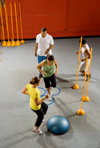Small-Group Training Techniques

Over the last several years, small-group personal training has dramatically increased in popularity. This form of training is not only time-effective for the personal trainer but economical for many clients unable to afford private sessions. However, many trainers who excel in a one-on-one training environment struggle when attempting to coordinate group sessions. Here are two techniques that can be helpful when you are trying to manage and structure a training session for three or more clients at once with limited equipment and resources. Integrate these techniques into a comprehensive training program.
Supersets
Supersets are a valuable tool for maximizing space and time during group training sessions. A superset can be defined as any two exercises—one performed immediately after the other, with minimal rest in between—that work an agonist and antagonist pair of muscles or muscle groups. An example would be a push-up immediately followed by a pull-up. This training method allows you to maximize workflow, using greater training loads, as you transition clients from one exercise to the next.
Combination Movements
Combination movements, or hybrid exercises, are another useful tool when equipment or time is limited. These exercises combine two to three traditional exercises to form one complete movement or repetition. An example would be a dumbbell squat followed immediately by an overhead press once the client reaches a standing position. Combination movements allow greater volumes of training to be performed and can improve metabolic efficiency.
Using just these two techniques alone, you can design virtually limitless training combinations and variations to keep your clients interested and challenged from one workout to the next. Below is a sample program of how these techniques can be used in creating an effective group training session. Clients would perform the exercises at the appropriate training load and then rotate from one station to the next with appropriate rest or transition time. Approximately 15 seconds of transition time is used in this model.
|
Sample Group Training Structure |
||
|
Perform the following section with all group members, beginning at Station 1 and progressing sequentially to Station 3. |
||
|
Station 1 |
Station 2 |
Station 3 |
|
foam rolling: 3-5 minutes |
general warm-up: 3-5 minutes |
dynamic warm-up: 3-5 minutes |
|
Station 1 |
Station 2 |
Station 3 |
|
barbell squat to overhead press |
Romanian dead lift to bent-over row |
crunches on stability ball |
|
Rest 3-5 minutes between series, and repeat twice before moving to the next series. |
||
|
dumbbell presses + TRX® Suspension Trainer™ rows |
lat pull-downs + push-ups |
reverse hyperextensions |
|
Rest 3-5 minutes between series, and repeat twice before moving to the next series. |
||
|
metabolic conditioning (10-20 minutes) |
||
To learn more about small-group training from Jay Dawes, attend his session, “Smokin’ Small-Group Training” at the IDEA Fitness Fusion Conference™, April 22-25, 2010, in Rosemont, Illinois. For more information, go to www.ideafit.com/conference/idea-fitness-fusion-2010. Special fitness conference payment options are available until March 9, 2010.
Jay Dawes, MS
Jay Dawes, MS, is the director of education for the National Strength and Conditioning Association in Colorado Springs, Colorado, where he is also an assistant coach at NSCAÔÇÖs Human Performance Center. Jay holds a masterÔÇÖs degree in health and human performance and is currently pursuing his doctorate degree in exercise science.
Certifications: ACSM, NSCA





